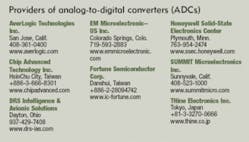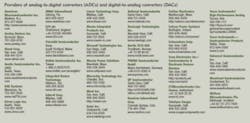By John Keller
Among the most critical components in any military and aerospace optical or RF system is the analog-to-digital (A-D) converter and digital-to-analog (D-A) converter. The reason: sensors must deal with the real world, which is analog, and process the information, which is handled digitally.
The imperatives for A-D and D-A converters in military systems are speed and clean signal, with size and power consumption coming in a close second. Military applications like radar and electronic warfare are among the most demanding applications for A-D and D-A converters, and require all the speed that industry can offer for complex signal processing, says Andrew Benn, product marketing manager for E2V plc in Chelmsford, England.
“The military is interested in a giant leap forward in technology, and has been after speeds in gigasamples per second,” Benn says. “If there is a missile coming at you, want to sample data as fast as you can.”
The A-D and D-A converter market breaks down essentially into three segments: consumer, industrial, and military/aerospace, Benn explains. Satisfactory A-D and D-A speeds for these applications range generally from 100 millisamples per second for consumer, 500 megasamples per second for industrial, and in excess of 1 gigasample per second for leading-edge military and aerospace applications.
Another high-end A-D and D-A converter designer is Analog Devices Inc. in Norwood, Mass., where engineers are trying to meet demand for flexible devices that enable systems designers to throttle-back the A-D and D-A devices to reduce power consumption.
“A-D and D-A converters are very friendly to this kind of operation,” says Dr. Mike Coln, division fellow for precision converters at the Analog Devices Signal Processing Group in Wilmington, Mass. “There is a trend where this sort of capability is inherent in the converter. Energy per conversion is a fixed value, so power consumption scales with the throughput.”
This capability entered the scene between 2000 and 2002, when “we started seeing converters that effectively shut down and stop consuming power when they finish a conversion,” Coln explains. “Prior to this, architectures did not support that type of operation, and still consumed power when they were not converting.”
Another trend in the converter business involves growing levels of system integration. “Those of us building converters are now recognizing that the increased level of integration we can provide gives us the opportunity to integrate more of the signal chain,” Coln says. Such an approach will enable converter manufacturers to package data-acquisition systems on a chip.
Analog Devices experts see an eventual migration in A-D converters to 16 bits, up from 10 and 12 bits. “For many applications in the past, the 12-bit level was considered adequate, but as time goes on the converter performance improves, and it might be appropriate to go to 16-bit converters,” Coln says.
null
null
null






